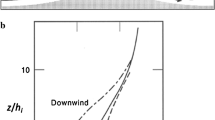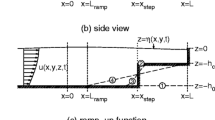Abstract
Observed boundary-layer circulations close to the confluence of the Negro and Solimões rivers near Manaus in the Brazilian equatorial Amazon forest were presented in Part I. These are shown through linear analysis and second-order turbulence modelling to be aspects of a river breeze superimposed on the basic flow. Linear analysis is presented to estimate the spatial structure and intensity of a breeze induced by a river with width and thermal contrast similar to that observed in the central Amazon. It is found that observed thermal contrasts are sufficient to produce a river breeze that can be perceived more than 20 km inland daily. A one-dimensional second-order closure model is used to show that observed nocturnal low-level wind maxima and diurnal surface wind rotation are aspects of a river breeze interacting with the seasonally-varying mean flow. At night, partial decoupling of the surface from the lower atmosphere allows the land breeze to be expressed as a low-level wind maximum. During the day, convective mixing communicates upper level winds to the surface during rapid morning boundary-layer growth. Rotation of the surface wind follows as the river breeze circulation is then superimposed.
Similar content being viewed by others
References
Abreu Sá, L. D., Viswanadham, Y., and Manzi, A. O.: 1986,Energy Receipt Partitioning over the Amazon Forest. Relatorio Tecnico, INPE-3980-PRE/990, Instituto de Pesquisas Espaciais, São José dos Carnpos, SP, Brazil.
André, J. C., De Moor, G., Lacarrere, P., and du Vachat, R.: 1975, ‘Turbulence Approximation for Inhomogeneous Flows: Part I. The Clipping Approximation’,J. Atm Sci. 33, 476–481.
Blackadar, A. K.: 1957, ‘Boundary Layer Wind Maxima and their Significance for the Growth of Nocturnal Inversions’,Bull. Am. Meteorol. Soc. 38, 283–290.
Brost, R. A. and Wyngaard, J. C.: 1978, ‘A Model of the Stably Stratified Planetary Boundary Layer’,J. Atm. Sci. 35, 1427–1440.
Burk, S. D.: 1977, ‘The Moist Boundary Layer with a Higher Order Turbulence Closure Model’,J. Atm. Sci. 34, 629–638.
Dalu, G. A. and Pielke, R. A.: 1989, ‘An Analytical Study of the Sea Breeze’,J. Am. Sci. 46, 1815–1825.
DeSouza, R.L., Aspliden, C. I., Garstang, M., Leseur, N. E., and Hsu, Y.: 1971, ‘A Low Level Jet in the Tropics’,Mon. Wea. Rev. 99, 559–564.
Deardorff, J.: 1968, ‘Dependence of Air-Sea Transfer Coefficients on Bulk Stability’,J. Geophys. Res. 73, 2549–2557.
Donaldson, C. DuP.: 1973, ‘Construction of a Dynamic Model of the Production of Atmospheric Turbulence and Dispersal of Pollutants’, in D. A. Haugen (ed.),Workshop on Micrometeorology. Am. Meteorol. Boston, 392 pp.
Fitzjarrald, D., Stormwind, B., Fisch, G., and Cabral, O.: 1988, ‘Turbulent Transport Observed Just Above the Amazon Forest’,J. Geophys. Res. 93(D2), 1551–1563.
Fitzjarrald, D., Moore, K., Scolar, J., Cabral, O., Manzi, A. O., and Sá, L. D.: 1990, ‘Daytime Turbulent Exchange Between the Amazon Forest and the Atmosphere’,J. Geophys. Res. 95(D10), 16825–16838.
Greco, S., Ulanski, S., Garstang, M., and Houston, S.: 1992, ‘Low-Level Nocturnal Maximum over the Central Amazon Basin’,Boundary-Layer Meteorol. 58, 91–115.
Harriss, R. C., Garstang, M., Wofsy, S. C., Browell, E. V., Molion, L. C. B., MacNeal, R. J., Hoell, J. M., Bendura, R. J., Beck, S. M., Navarro, R. L., Riley, J. T., and Snell, R. L.: 1988, ‘The Amazon Boundary Layer Experiment (ABLE 2A): Dry Season 1985’,J. Geophys. Res. 93, 1351–1360.
Harriss, R. C., Wofsy, S. C., Garstang, M., Beck, S. M., Bendura, R. J., Coelho, J. R. B., Drewry, J. W., Hoell, J. M., Matson, P. A., MacNeal, R. J., Molion, L. C. B., Navarro, R. L., Rabine, V. and Snell, R. L.: 1990, ‘The Amazon Boundary Layer Experiment: Wet Season 1987’,J. Geophys. Res. 95, 16721–16736.
Kondo, H. and Gambo, K.: 1979, ‘The Effect of the Mixing Layer on the Sea Breeze Circulation and the Diffusion of Pollutants Associated with Land-Sea Breezes’,J. Meteorol. Soc. Japan 57, 560–575.
Hsu, S. A.: 1979, ‘Mesoscale Nocturnal Jet-Like Winds Within the Planetary Boundary Layer over a Flat, Open Coast’,Boundary-Layer Meteorol. 17, 485–495.
Lemone, M. E., Barnes, G. M., Fankhauser, J. C., and Tarleton, L. F.: 1988, ‘Perturbation Pressure Fields Measured by Aircraft around the Cloud-Base Updraft of Deep Convective Clouds’,Mon. Wea. Rev. 116(2), 313–327.
Martin, L. C., Fitzjarrald, D., Garstang, M., Oliveira, A. P., Greco, S., and Browell, E.: 1988, ‘Structure and Growth of the Mixing Layer over the Amazonian Rain Forest’,J. Geoph. Res. 93, 1361–1375.
McNider, R. T. and Pielke, R. A.: 1981, ‘Diurnal Boundary-Layer Development over Sloping Terrain’,J. Atm. Sci. 38, 2198–2212.
Mellor, G. L. and Yamada, T.: 1974, ‘A Hierarchy of Turbulence Closure Models for Planetary Boundary Layers’,J. Atm. Sci. 31, 1791–1882.
Mellor, G. L. and Yamada, T.: 1982, ‘Development of a Turbulence Closure Model for Geophysical Fluids Problems, Reviews of Geophysics and Space Physics’,20, 851–875.
Miller, W. F., Pielke, R. A., Garstang, M., and Greco, S.: 1989, ‘Simulations of the Mesoscale Circulation in the ABLE II Region’,Proc. Third Intern. Conf. on Southern Hermisphere Meteorology and Oceanography, Nov. 13–17, Buenos Aires.
Moore, C. J. and Fisch, G.: 1986, ‘Estimating Heat Storage in Amazonian tropical Forest’,Agricult. Forest Metorol. 38, 147–169.
Nieuwstadt, F. T. and Tennekes, H.: 1981, ‘A Rate Equation for Nocturnal Boundary Layer Height’,J. Atm. Sci. 38, 1418–1428.
Oliveira, A. P.: 1990, ‘The Dynamics of the Planetary Boundary Layer over the Amazon Rain Forest, Ph. D. dissertation, Department of Atmospheric Sciences, State University of New York, Albany, 296 pp.
Oliveira, A. P. and Fitzjarrald, D. R.: 1992, ‘The Amazon River Breeze and the Local Boundary Layer: I, Observations’,Boundary Layer Meteorol. 63, 141–162.
Pielke, R. A. and Segal, M.: 1986, ‘Mesoscale Circulations Forced by Differential Terrain Heating’, 516–548. Chapter 22 ofMesoscale Meteorology and Forecasting, Edited by P. S. Ray, p. 793.
Press, W. H., Flannery, B. P., Teukolsky, S. A., Vetterling, W. T.: 1986,Numerical Recipes: The Art of Scientific Computing, Cambridge University Press, Cambridge, p. 818.
Roach, W. T. and Slingo, A.: 1979, ‘A High resolution Infrared Radiative Transfer Scheme to Study the Interactions of Radiation with Cloud’,Quart. J. R. Meteorol. Soc. 105, 603–614.
Rotunno, R.: 1983, ‘On the Tinear Theory of the Land and Sea Breeze’,J. Atm Sci. 40, 1999–2000.
Schumann, U.: 1977, ‘Realizability of Reynolds-Stress Turbulence Models’,Physics Fluids 20, 721–725.
Sellers, P. J.: 1988, ‘Modelling Effects of Vegetation on Climate:The Geophysiology of Amazonia Vegetation and Climate Interactions, Ch. 16, 297–344, R. E. Dickinson (ed.), John Wiley Sons, 526 pp.
Shuttleworth, W. J., Gash, J., Lloyd, J., Moore, C. J., Robert, C. J., Filho, A., Fisch, G., Filho, V., Ribeiro, M., Molion, L., de Abreu Sá, L., Nobre, C., Cabral, O. M. R., Patel, S. R., and Moraes, J. C.: 1984; ‘Observations of Radiation Exchange Above and Below Amazonian Forest’,Quart. J. Roy. Meteorol. Soc. 110, 1163–1169.
Sommeria, G.: 1976, ‘Three-Dimensional Simulation of Turbulent Processes in an Undisturbed Trade Wind Boundary Layer’,J. Atm. Sci. 33, 216–241.
Stormwind, B. L.: 1988, ‘Turbulent Transport Above the Amazon Forest’, M.S. Thesis. State University of New York at Albany, 121 pp.
Stull, R. B.: 1988,An Introduction to Boundary Layer Meteorology, Kluwer Academic Publishers, Boston, 666 pp.
Wexler, H.: 1961, ‘A Boundary Layer Interpretation of the Low Level Jet’,Tellus 13, 368–378.
Wippermann, F.: 1973, ‘Numerical Study on the Effects Controlling the Low-Level Jet’,Beiträge zur Physik der Atmosphäre 46, 137–154.
Yamada, T. and Mellor, G.: 1975, ‘A Simulation of the Wangara Atmospheric Boundary Layer Data’,J. Atm. Sci. 32, 2309–2329.
Zhang, D. and Anthes, R. A.: 1982, ‘A High Resolution Model of the Planetary Boundary Layer-Sensitivity Tests and Comparisons with the SESAME-79 Data’,J. Appl. Meteorrol. 21, 1594–1609.
Author information
Authors and Affiliations
Rights and permissions
About this article
Cite this article
De Oliveira, A.P., Fitzjarrald, D.R. The Amazon river breeze and the local boundary layer: II. Linear analysis and modelling. Boundary-Layer Meteorol 67, 75–96 (1994). https://doi.org/10.1007/BF00705508
Revised:
Issue Date:
DOI: https://doi.org/10.1007/BF00705508




